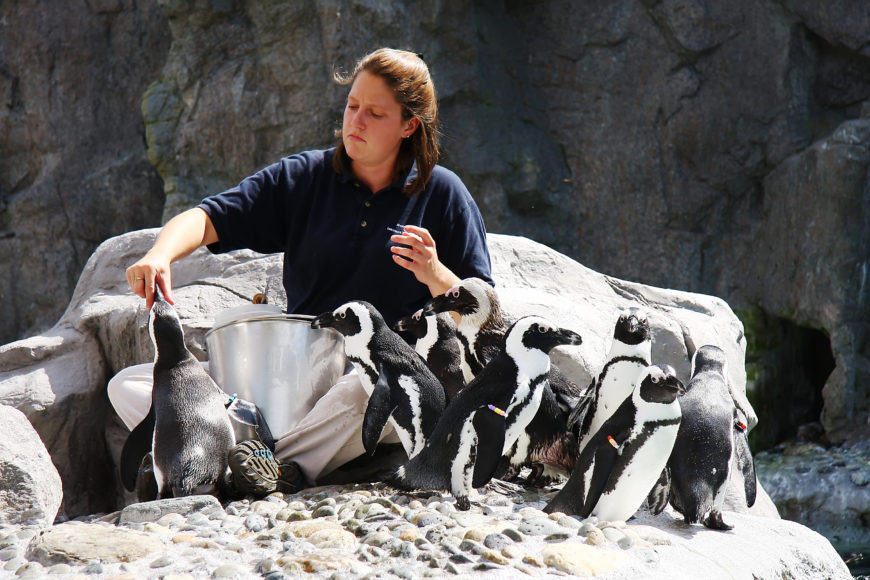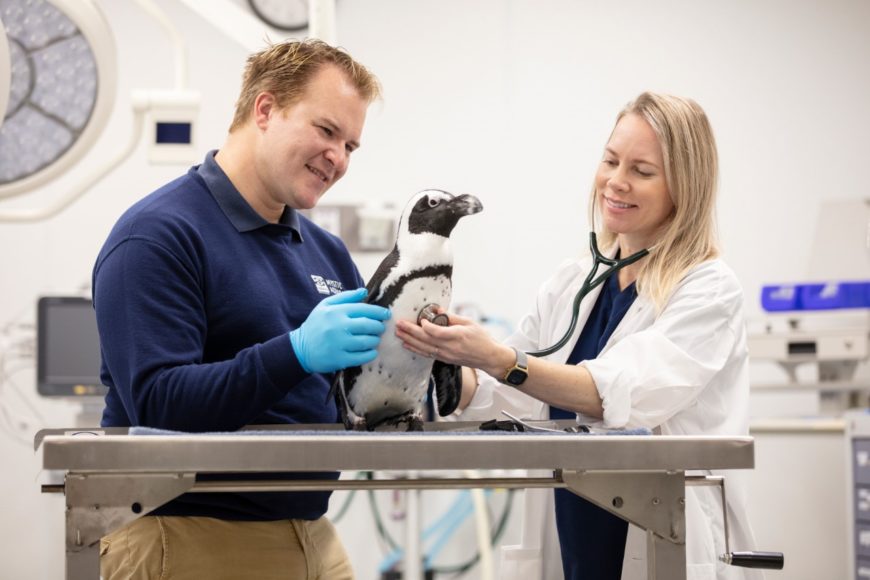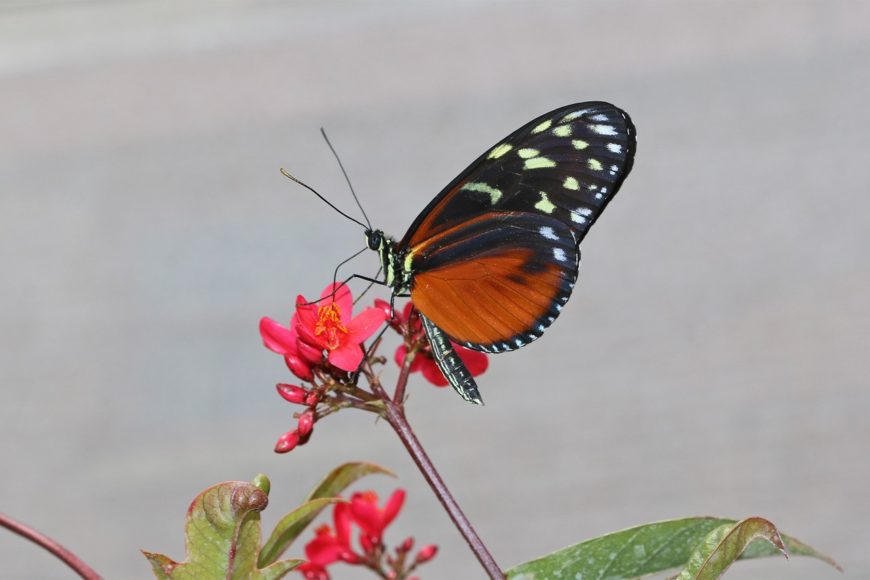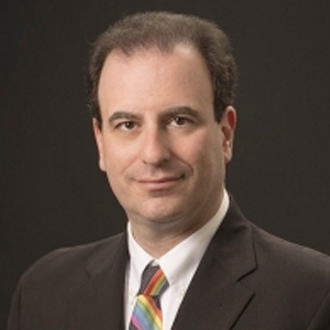Connecticut’s Mystic Aquarium is home to 800 different species, ranging from the tiny, seemingly fragile seahorse to the not-tiny and anything-but-fragile beluga whale. And for the 800,000 visitors who travel through the aquarium every year, the animals appear to be the picture of good health.
But when the aquarium’s residents are not in the best of health, the on-site Milne Ocean Science and Conservation Center provides a 24/7 medical suite that could easily be mistaken for a hospital setting, albeit with a few distinctive differences.
“You’ll notice we have this big hydraulic lift table,” says Molly Martony, D.V.M., a senior veterinarian at the aquarium. “We’re able to utilize it for our large mammals, like a sea lion or a Steller sea lion. And then, we have two different types of ventilators which, when the animals are under anesthesia, support their lungs and help me to prove that they’re stable.
“We can’t transport animals off-site to other places,” she adds. “We’re really grateful for a wonderful setup. And we have a lot of equipment that is so great, such as the portable X-ray unit that we can take poolside and take images of our beluga whales. And we have all of the equipment that you’d need going to a gastroenterologist. We’re certainly well-equipped to rise to the need of any occasion.”
Martony says that the wide variety of exotic animals at the aquarium requires the veterinary staff to have special training that goes far beyond the domestic animal medical care that is taught in veterinary schools.
“We go through additional training after veterinary school for many years to become experts,” she says. “And there are additional examinations and a lot of different hoops to jump through, so to speak, to be able to know how to treat each one of those species.”
And the depth and scope of ailments and illnesses treated by the aquarium’s staff is astonishing, from healing a sea lion’s injured flipper to ensuring the dental quality of the beluga whale’s teeth. But unlike many dogs and cats who become skittish when taken to a vet’s clinic, the aquarium’s sea mammals go out of their way to help Martony and her staff.
“The mammals are trained and participate in their own health care, which is really amazing,” she says. “Through those relationships the trainers have with the animals, they’re able to voluntarily do some of the behaviors that actually help us take better care of them and assess their health. Some of those things include letting the veterinarians do ultrasound and full body examinations, in addition to blood sampling and respiratory sampling collection, amongst other things.”
While the aquarium does not provide a specific figure on its annual operating costs for the veterinary services, roughly 30% of its $25 million operating budget is devoted to the animals’ medical care. And though the veterinary staff tries to keep a handle on costs by purchasing medications in bulk, Martony says the “aquarium is really supportive in providing the resources that we need. There isn’t typically a medication that is too expensive for animals, and one of the benefits here is that, in some ways, we don’t really focus on the cost and whether or not we want to give the drug — which sometimes can differ in a small-animal practice when you’re working with dogs and cats and clients that have a fixed budget, and you’re trying to make the medicine fit in that box. But here, money is no object. That’s not a great concern for our day to day.”
She adds that the labor shortage and so-called “Great Resignation” that are reshaping the wider economy do not affect her sections within the aquarium.
“I’ve been here for a year and a half,” she says. “We’re specialty trained with additional internships and residency programs to be board-certified specialists in this area of medicine. The jobs are a little bit fewer and farther to come by, so certainly when you’re able to get one of those dream jobs people try to hold on to them.”
With all that additional schooling, the aquarium’s trainers and husbandry staff that work with the animals on a daily basis offer invaluable insight on whether a medical problem is occurring, she says:
“They’re able to pick up on subtle changes early on. We pride ourselves on picking up on things before they become an issue for that animal and before they become truly sick.”
The aquarium does not highlight its veterinary services to the public, and Martony acknowledges that few people are aware of the work that is done behind the scenes to ensure the animals’ wellness. The aquarium’s veterinary care was recently in the spotlight over the passing of two beluga whales that were among five animals brought last year from an overcrowded marine habitat in Canada. One died from a preexisting gastrointestinal condition last August shortly after its arrival, while the cause of the second whale’s passing in February has yet to be determined.
“As with any living animal, there is illness and death,” Martony says. “We have geriatric populations of animals here, and some of our penguins live incredibly long lifespans into their 30s and even 40s. It depends on the species and not the population, and we’ve strived to provide world class health care for them. But unfortunately, (death) is part of the job.”
Mystic Aquarium is at 55 Coogan Blvd. For more, call 860-572-5955 or visit mysticaquarium.org.
Butterflies flit at The Maritime Aquarium at Norwalk
Butterflies are perhaps the prettiest representatives of the insect world, yet there is far more to their role within the wider ecosystem than a decorative presence. The Maritime Aquarium at Norwalk is calling attention to the importance of butterflies in “Flutter Zone,” a special walk-through exhibit to be held Memorial Day through Labor Day (May 28 through Sept. 5).
“In summer, The Maritime Aquarium tries to have a special exhibit for guests,” says Dave Sigworth, associate director of communications. “Summer is our busiest time. It’s when recreational visitors are out and about looking for something fun to do, and they may have come to The Maritime Aquarium recently, but they haven’t seen what we offer them in the summer. So, it’s a great chance for us to have something special that relates to nature, not necessarily directly connected to Long Island Sound or the oceans.”
The aquarium hosted “Flutter Zone” exhibitions in 2015 and 2016 that were extremely popular with the public. In heading beyond the confines of the Covid pandemic, the aquarium was eager to have an outdoors presentation that celebrated life, color and movement.
Sigworth describes the “Flutter Zone” as resembling an “aviary structure that’s on our riverfront courtyard. It’s basically a walk-through. You walk in one door, there’s a boardwalk path that goes down and loops around and comes back and brings you out the other door.” (This is similar to The Butterfly Conservatory at the American Museum of Natural History in Manhattan through May 30.)
Within the structure in Norwalk will be hundreds of butterflies at different stages of their development. Visitors will be able to look into a temperature-controlled space where the chrysalises are waiting to open while strolling amid what Sigworth calls “a good full supply of butterflies” in colorful flight and serene recreation.
However, the butterflies on display are not local residents. According to Barrett Christie, the aquarium’s director of animal husbandry, they are being brought in from specialty suppliers in Central and South America and from Africa.
“They are unpacked and inspected carefully in a bio-secure facility under strict controls to make sure they are not carrying any unwanted pests or parasitoids and allowed to complete their metamorphosis and emerge as butterflies under controlled conditions,” says Christie. “The butterflies are then transferred to the main exhibit, where most species will live about two to four weeks on average.”
Sigworth added that the foreign butterflies will be contained in the exhibit and have zero chance of becoming an invasive species.
“One of the important aspects of the exhibit is that when you go into it, you’re actually going to go through two doors,” he says. “And as you exit, there’ll be mirrors and door staff to make sure that there isn’t a butterfly on your back or anything that will allow them to leave this enclosure.”
The exhibit will emphasize the role that butterflies play as pollinators within agricultural and horticultural environments, and it will call on visitors to recognize the role they can play in supporting local species, including the monarch butterfly. And, of course, the exhibition will offer a chance for people to interact with butterflies.
“A lot of times, the butterflies will land on you and kids enjoy that,” Sigworth says. “They try to get them to land on a hand or finger.”
While this is the third time “Flutter Zone” is being staged at the aquarium, Sigworth wasn’t certain if this would become a regular summer presentation.
“We always look for different things,” he says, noting that the aquarium’s lineup for summer will include a family-friendly, octopus-focused event on June 14 — “Science Friday’s Cephalopod Week,” emceed by NPR “Science Friday” radio host Ira Flatow — as well as the annual summer public cruises and camp. Still, he acknowledges the butterflies will probably steal the show for the summer.
“Their colors can be quite gorgeous,” he says, “some really bright blues or different patterns and blends of colors. They’re really gorgeous animals.”
The Maritime Aquarium at Norwalk is at 10 N. Water St. For more, call 203-852-0700 or visit maritimeaquarium.org.
— Phil Hall







